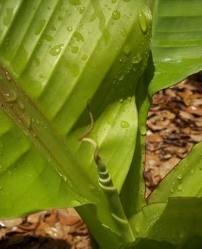Musa
These are treelike, herbaceous plants that live in warm countries and are suitable for outdoor cultivation in the United States only in the warmer parts of Florida and other frost-free climates. They may be grown a bit further in the north if fruit is not the aim. They can be grown in hothouses in colder areas, or outside during the summer months for the tropical beauty of their large, paddle-shaped leaves. The "stems" of these plants are made of overlapping leaf sheaths that die after flowering. The dwarf Banana, or M. cavendishii, has a cluster of leaves that grow from 5 to 6 feet from a trunk-like stem. It produces creamy, fingerlike flowers that are protected by large, maroon bracts and are followed by deliciously flavored Bananas that are edible without cooking. This is one of the most popular to grow outside in the far South and it's great for growing in large tubs in warm greenhouses, where, with little attention, is fruits readily. It is a native of southern China. The common Banana is M. paradisiaca subspecies sapientum. It can grow to 15 or 20 feet tall and produce seedless, nourishing fruits. There are many different kinds; most having yellow skin, but some are red. Some of the better-known varieties are: Gros Michel, Red Jamaica, Apple, Orinoco and Champa (Lady-Finger Banana). Variety vittatum has beautiful foliage that is variegated white and pink. The Plantain, M. paradisiaca, is a species of Musa that grows about 30 feet high and produces green or greenish-yellow seedless fruits that can be eaten after they have been cooked. It isn't grown much in the United States, but in most tropical countries it is a part of the staple diet. It's probably a native of India. M. textilis produces the valuable fiber called Manila Hemp or Abaca. It is commercially produced in the Philippines where it is a native. This plant can grow to a height of about 20 feet. Its inedible fruits produce many black seeds. It is rarely grown in America. M. basjoo is grown as a source of fiber used in making coarse fabrics in southern Japan and M. ensete, its counterpart, is in Africa.
Although these plants don't produce edible fruit, they are still great plants to grow for their beauty. M. ensete, the Abyssinian Banana or Ethiopian Banana, is a pretty Palm-like plant that grows to very large sizes. Its long, tapering leaves are olive green with a maroon midrib. They grow 20 feet or so in length. The flowers are produced intermittently throughout the year in long, terminal spikes. The flowers are red-green with red bracts. These are followed by small, dry, inedible fruits that resemble Bananas. This plant is originally from tropical Africa. Another name for this plant is Ensete ventricosum.
Pot Cultivation
Musas need rich soil that is kept moist during its period of active growth. It should not be allowed to dry completely. The soil should contain generous amounts of humus - preferably rich compost or well-rotted manure. In cooler climates, these plants require a large heated greenhouse where the temperature doesn't fall below 60 degrees in the winter and a least 10 degrees higher from spring through fall. M. ensete and M. basjoo can stand lower temperatures. The minimum height for the greenhouse should be at least 25 feet. Plants that are grown in pots or tubs should be repotted yearly. If they are already in containers as large as can be handled, they should be top-dressed every spring. If they are kept indoors, light shade from the strongest sun should be provided, but plants grown outside for the summer can stand full sun. Specimens that have their containers filled with roots will benefit from weekly applications of dilute liquid fertilizer. They need a humid atmosphere and should be sprayed with a lot of water on clear days. Growing Musas in containers tends to restrict the growth making them more suitable for a confined space. In climates that allow Musas to be planted outside for their ornamental foliage, they should be in sheltered spots where they will be somewhat protected from strong winds, which will most likely shred their huge leaves.
Propagation
This plant is easily propagated using sucker growths found at the base of the old plants. The rooted suckers are taken off and planted, first in small pots and after a few months, in tubs, boxes, or open beds, where they are to grow and fruit. Spring is the best time to plant rooted suckers. If the young plants are kept in a temperature of 65 degrees at night, with a 10- to 20-degree increase during the day, kept well-watered and given liquid fertilizer every week, they will grow quickly and fruit will be produced by the next summer. The main stem dies after bearing fruit and the suckers grow to replace it.
 |
M. Basjoo |
VARIETIES
- M. paradisiaca sapientum (the common Banana);
- M. nana or M. Cavendishii (the dwarf Banana);
- M. paradisiaca (Plantain);
- M. textilis;
- M. Basjoo;
- M Ensete;
M. rosacea;
M. sumatrana;
M. zebrina;
M. malaccensis;
M. coccinea.





